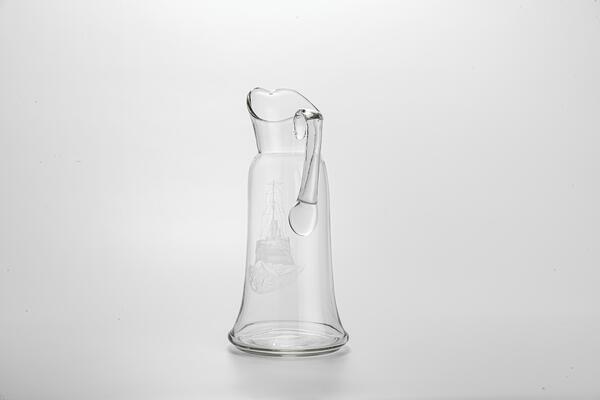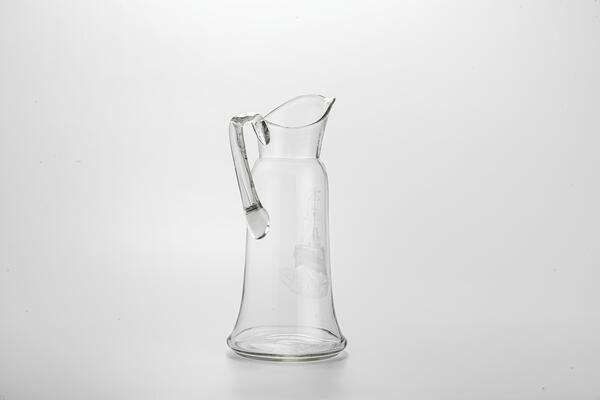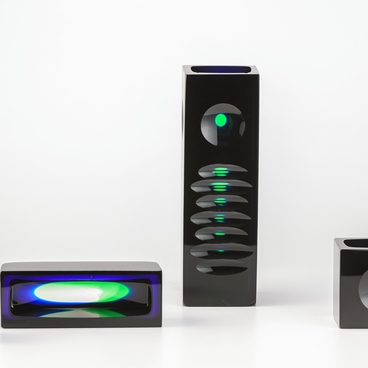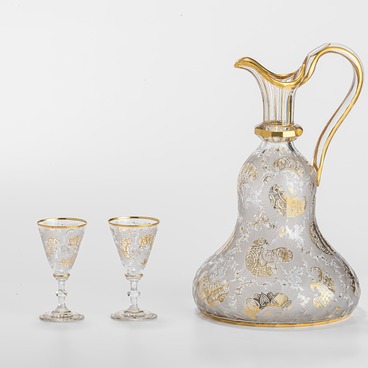The 1930s were a period of upsurge for the Red Giant factory after a difficult previous decade.
The factory resumed production of high quality glass, as well as mass market glassware and products commissioned by the railways and the merchant fleet. In addition to traditional patterns and drawings, designers resorted to depicting the narratives that were crucial for Soviet society. The famous Krasin icebreaker was also immortalized in glass.
The icebreaker was designed and built at an English shipyard. She became an upgraded and more powerful version of the Yermak — the first icebreaker designed to operate in harsh Arctic conditions. In 1917, after fixing all the problems, she was launched as part of the Russian navy in the Arctic Ocean.
Initially known as the Svyatogor, the icebreaker alternately belonged to the Russians and the British, was scuttled and raised. In 1922, Russia bought the icebreaker back, thanks largely to the efforts of the Soviet diplomat Leonid Borisovich Krasin — the ship was later renamed in his honor.
In 1928, the airship “Italia” with General Umberto Nobile on board crashed on the ice when it was returning from an expedition to the North Pole. Several ships were sent to help the surviving members of the crew, but only the Krasin managed to reach the ice camp and rescue the people. On the way home, the icebreaker team came to the rescue of the German ship Monte Cervantes. The vessel with 1,500 people on board, including passengers and crew, was damaged after hitting an iceberg.
For this campaign, the icebreaker received the honorary Order of the Red Banner of Labor.
The Nikolsky engraver Pyotr Alexandrovich Porokhov depicted the legendary icebreaker in the form of a detailed matte engraving on the surface of a large pitcher. The image became a symbol of the power and heroism of the young state.
Pyotr Porokhov worked a lot with the artists Vera Mukhina, Alexey Uspensky, and Nikolay Tyrsa. In 1949, he was invited to the Leningrad Art Glass Factory to train local artisans.
His best artworks are housed in the Nikolsky Museum of Glass and Crystal, as well as in the Museum of Art Glass in St. Petersburg.
The factory resumed production of high quality glass, as well as mass market glassware and products commissioned by the railways and the merchant fleet. In addition to traditional patterns and drawings, designers resorted to depicting the narratives that were crucial for Soviet society. The famous Krasin icebreaker was also immortalized in glass.
The icebreaker was designed and built at an English shipyard. She became an upgraded and more powerful version of the Yermak — the first icebreaker designed to operate in harsh Arctic conditions. In 1917, after fixing all the problems, she was launched as part of the Russian navy in the Arctic Ocean.
Initially known as the Svyatogor, the icebreaker alternately belonged to the Russians and the British, was scuttled and raised. In 1922, Russia bought the icebreaker back, thanks largely to the efforts of the Soviet diplomat Leonid Borisovich Krasin — the ship was later renamed in his honor.
In 1928, the airship “Italia” with General Umberto Nobile on board crashed on the ice when it was returning from an expedition to the North Pole. Several ships were sent to help the surviving members of the crew, but only the Krasin managed to reach the ice camp and rescue the people. On the way home, the icebreaker team came to the rescue of the German ship Monte Cervantes. The vessel with 1,500 people on board, including passengers and crew, was damaged after hitting an iceberg.
For this campaign, the icebreaker received the honorary Order of the Red Banner of Labor.
The Nikolsky engraver Pyotr Alexandrovich Porokhov depicted the legendary icebreaker in the form of a detailed matte engraving on the surface of a large pitcher. The image became a symbol of the power and heroism of the young state.
Pyotr Porokhov worked a lot with the artists Vera Mukhina, Alexey Uspensky, and Nikolay Tyrsa. In 1949, he was invited to the Leningrad Art Glass Factory to train local artisans.
His best artworks are housed in the Nikolsky Museum of Glass and Crystal, as well as in the Museum of Art Glass in St. Petersburg.





